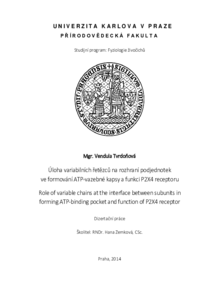Úloha variabilních řetězců na rozhraní podjednotek ve formování ATP-vazebné kapsy a funkci P2X4 receptoru
Role of variable chains at the interface between subunits in forming ATP-binding pocket and function of P2X4 receptor
dizertační práce (OBHÁJENO)

Důvod omezené dostupnosti:
Přílohy práce nebo její části jsou nepřístupné v souladu s čl. 18a odst. 7 Studijního a zkušebního řádu Univerzity Karlovy v Praze ve spojení s čl. 9 opatření rektora č. 6/2010.
Zobrazit/
Trvalý odkaz
http://hdl.handle.net/20.500.11956/66996Identifikátory
SIS: 93383
Kolekce
- Kvalifikační práce [19600]
Autor
Vedoucí práce
Oponent práce
Novotný, Jiří
Vlachová, Viktorie
Fakulta / součást
Přírodovědecká fakulta
Obor
Fyziologie živočichů
Katedra / ústav / klinika
Katedra fyziologie
Datum obhajoby
2. 12. 2014
Nakladatel
Univerzita Karlova, Přírodovědecká fakultaJazyk
Čeština
Známka
Prospěl/a
Klíčová slova (česky)
HEK293 buňky, purinergní receptory, P2X4 receptor, mimobuněčný adenosin-5'-trifosfát, ivermektin, iontový kanál, deaktivace, desenzitizace, dilatace póru, vazebné místo pro ATP, zelený fluorescenční protein, mutageneze, EC50Klíčová slova (anglicky)
HEK293 cell, purinergic receptor, P2X4 receptor, extracellular adenosin-5'-triphosphate, ivermectin, ion channel, deactivation, dilatation, desensitization, ATP-binding site, green fluorescent protein, mutagenesis, EC505 ABSTRAKT Krystalizace P2X4 receptoru (P2X4R) ze zebřičky ("zebra fish", zfP2X4) v uzavřeném a otevřeném stavu odhalila změny v konformacích ektodomény včetně změn v oblasti styčných ploch mezi levou ("left flipper"; LF) a hřbetní ("dorsal fin"; DF) ploutví. Roli těchto struktur ve formování ATP vazebné kapsy a funkci receptoru jsme zkoumali pomocí alaninové skenovací mutageneze úseků LF (D280-N293) a DF (R203-L214) potkaního P2X4R, a s využitím ATP a analogických agonistů 2-(methylthio)adenosin 5'- trifosfátu, adenosin 5'-(γ-thio)trifosfátu, 2'(3'-O-(4-benzoylbenzoyl)adenosin 5'- trifosfátu a α,β-methylenadenosin 5'-trifosfátu. Sníženou citlivost anebo účinnost ATP mělo 15 z 26 vytvořených mutací. Mutace R203A, N204A a N293A byly v podstatě nefunkční, ale jejich funkci bylo možné obnovit ivermektinem, alosterickým modulátorem P2X4R. Mutace I205A, T210A, L214A, P290A, G291A a Y292A měly změněnou odpověď na ATP a na analogické agonisty. Naproti tomu mutace L206A, N208A, D280A, T281A, R282A a H286A nevykazovaly ve srovnání s divokým typem receptoru žádnou změnu v odpovědích na ortosterické agonisty. Tyto pokusy, společně s homologním modelováním ukázaly, že aminokyseliny z první skupiny nacházející se v horní části obou řetězců LF a DF, se podílejí na přesné organizaci ATP-vazebné kapsy a iniciaci převodu...
7 ABSTRACT Crystallization of the zebrafish P2X4 receptor in both open and closed states revealed conformational differences in the ectodomain structures, including the dorsal fin and left flipper domains. The role of these domains in forming of ATP-binding pocket and receptor function was investigated by using alanine scanning mutagenesis of the R203- L214 (dorsal fin) and the D280-N293 (left flipper) sequences of the rat P2X4 receptor and by examination of the responsiveness to ATP and orthosteric analog agonists 2- (methylthio)adenosine 5'-triphosphate, adenosine 5'-(γ-thio)triphosphate, 2'(3'-O-(4- benzoylbenzoyl)adenosine 5'-triphosphate, and α,β-methyleneadenosine 5'- triphosphate. ATP potency/efficacy was reduced in 15 out of 26 alanine mutants. The R203A, N204A, and N293A mutants were essentially non-functional, but receptor function was restored by ivermectin, an allosteric modulator. The I205A, T210A, L214A, P290A, G291A, and Y292A mutants exhibited significant changes in the responsiveness to orthosteric analog agonists. In contrast, the responsiveness of L206A, N208A, D280A, T281A, R282A, and H286A mutants to analog agonists was comparable to that of the wild type receptor. These experiments, together with homology modeling, indicate that residues of the first group located in the upper part of...
